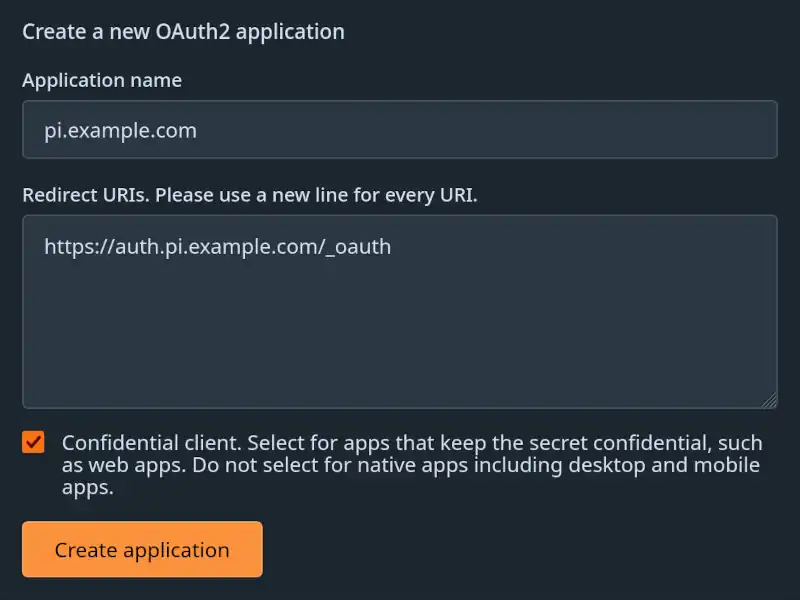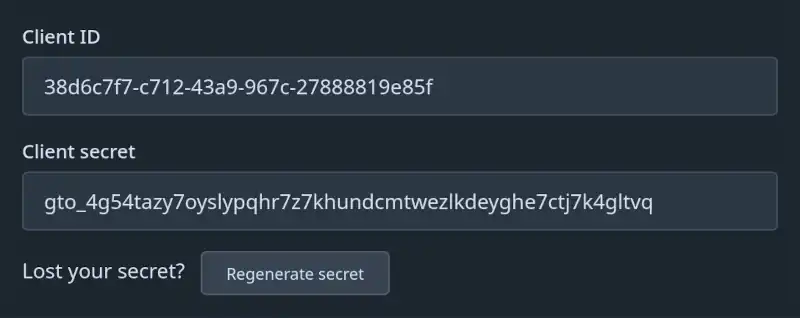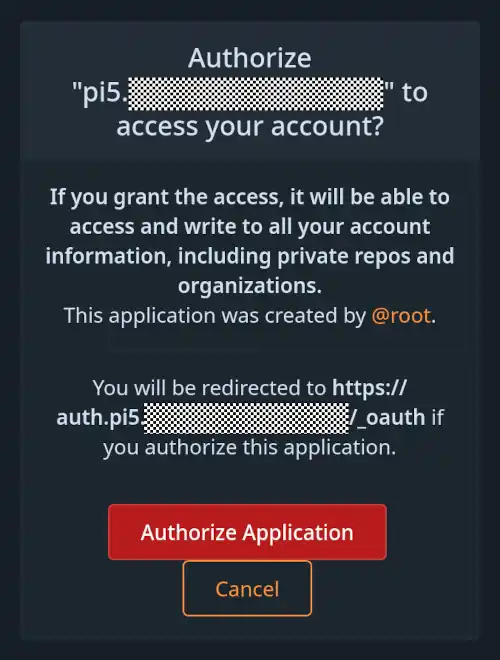Traefik-Forward-Auth (sentry authorization)
---
title: Traefik Forward Auth middleware handles authentication
---
sequenceDiagram
participant User
participant Traefik
participant TFA as TFA middleware
participant Forgejo as Oauth2 provider - Forgejo
participant HeaderAuth as Sentry authorization middleware
participant App
User ->> Traefik: HTTP request
Traefik ->> TFA: Sends the request to TFA middleware
TFA ->> Forgejo: OAuth2 authentication
Forgejo -->> TFA: OAuth2 response (returns OK / KO)
TFA -->> Traefik: Returns OK / KO
alt KO
Traefik ->> User: KO, access denied
else OK
Traefik -->> User: OK, logged in
User -->> Traefik: Send new requests with auth cookie.
end
Traefik ->> HeaderAuth: Send cookie token in trusted header for verification
HeaderAuth ->> Traefik: Returns OK / KO
alt KO
Traefik ->> User: KO, Returns error
else OK
Traefik -->> App: OK, Forwards trusted connection to backend app container
App -->> Traefik: OK, App returns response
Traefik -->> User: OK, app returns response
end
Sentry authorization
Some apps may already have their own authentication mechanisms, while others may not. Sentry authorization creates a common authentication and authorization framework in front of your applications via Traefik middleware. Sentry authorization happens before any existing auth mechanisms in the app itself, and so it acts as a front door gatekeeper for your apps. It can’t control what users are allowed to do once they get in, but it does control who is allowed in through the front door.
- Users are authenticated via the Forgejo instance and traefik-forward-auth.
- Users are authorized by a group membership filter applied on a per-app basis.
Configure traefik-forward-auth
pi make traefik-forward-auth config
TRAEFIK_FORWARD_AUTH_HOST: Enter the traefik-foward-auth host domain name (eg. auth.example.com) : auth.pi.example.com TRAEFIK_FORWARD_AUTH_COOKIE_DOMAIN: Enter the cookie domain name (ie ROOT domain) (eg. example.com) : pi.example.com ? Select the OAuth provider to use > gitea github google discord TRAEFIK_FORWARD_AUTH_GITEA_DOMAIN: Enter your gitea domain name (eg. git.example.com) : git.pi.example.com
At this point it will open w3m to the gitea instance asking you to
sign in. Because this isn’t very user friendly, so just press q and
then y to quit w3m.
- Open your preffered web browser and open up the gitea URL:
https://git.pi.example.com - Make sure you are logged in as the
rootuser. - Open the root user settings page, click
Applications. - Fill in the section titled
Manage OAuth2 applications:- Enter an application name as a public identifier.
- Enter the redirect URI
https:://auth.pi.example.com/_oauth.
- Click
Create Application.

- This will show you the OAuth2 client ID and secret:

Back in your terminal session, it should be asking you to fill these same details in:
TRAEFIK_FORWARD_AUTH_PROVIDERS_GENERIC_OAUTH_CLIENT_ID: Copy and Paste the OAuth2 client ID here : 38d6c7f7-c712-43a9-967c-27888819e85f TRAEFIK_FORWARD_AUTH_PROVIDERS_GENERIC_OAUTH_CLIENT_SECRET: Copy and Paste the OAuth2 client secret here : gto_4g54tazy7oyslypqhr7z7khundcmtwezlkdeyghe7ctj7k4gltvq TRAEFIK_FORWARD_AUTH_LOGOUT_REDIRECT: Enter the logout redirect URL : https://git.pi.example.com/logout
Install Traefik-Forward-Auth
pi make traefik-forward-auth install
Add a new route on the sentry
sentry route set --layer7 auth.pi.example.com 10.13.16.2 443 --proxy-protocol true
You may also create the route interactively through the Traefik config menu.
Add user groups for sentry authorization
With OAuth2 sentry authorization enabled, users are authorized to access apps only if they are a member of an authorized group for that app. You need to create the group membership lists in the Traefik config:
pi make traefik config
? Traefik: > Config Install (make install) Admin Exit (ESC) ? Traefik Configuration: Traefik user Entrypoints (including dashboard) TLS certificates and authorities > Middleware (including sentry auth) Advanced Routing (Layer 7 / Layer 4 / Wireguard) Error page template v Logging level ? Traefik middleware config: MaxMind geoIP locator > OAuth2 sentry authorization (make sentry) ? Sentry Authorization Manager (main menu): > Group Manager User Manager List all members List authorized callback URLs Quit > Sentry Authorization Manager (main menu): Group Manager ? Choose a group to manage > Create a new group ? Enter the name of the group to create: admin > Do you want to add users to this group now? Yes Enter the new user id(s) to add, one per line: ? Enter a user ID (Press Esc or enter a blank value to finish) me@example.com
Replace me@example.com with the same email address that you used
to sign up for your personal account in Forgejo. You can add more
users to the group if you wish, when done enter a blank line.
Re-configure whoami with sentry authorization (OAuth2)
pi make whoami config
WHOAMI_TRAEFIK_HOST: Enter the whoami domain name (eg. whoami.example.com) : whoami.pi.example.com ? Do you want to enable sentry authorization in front of this app (effectively making the entire site private)? No Yes, with HTTP Basic Authentication > Yes, with Oauth2 Yes, with Mutual TLS (mTLS) ? Which authorization group do you want to permit access to this app? > admin
This will allow only the admin authorization group to access this
instance.
Remember, you can create extra authorization groups in the Traefik config, that way you can have separate user access per instance.
Re-install whoami:
pi make whoami install
Test login for whoami
Open the whoami app in your web browser: https://whoami.pi.example.com.
You should be automatically redirected to the Foregjo app to login.
The first time a Forgejo user authenticates to a sentry authorization protected app, they should see this prompt:

Confirm by clicking the button Authorize Application.
If the user is authorized, they should be automatically redirected back to the whoami app.
The output of whoami now reflects the authorized user:
Name: default Hostname: c863ccd86cec IP: 127.0.0.1 IP: ::1 IP: 172.19.0.2 RemoteAddr: 172.19.0.1:38606 GET / HTTP/1.1 Host: whoami.pi.example.com User-Agent: Mozilla/5.0 (X11; Linux x86_64; rv:127.0) Gecko/20100101 Firefox/127.0 Accept: text/html,application/xhtml+xml,application/xml;q=0.9,image/avif,image/webp,*/*;q=0.8 Accept-Encoding: gzip, deflate, br, zstd Accept-Language: en-US,en;q=0.5 Cookie: _forward_auth=xxxxxxxxxxxxxxxxxxxxxxxxxxx=|123456789|me@example.com Dnt: 1 Priority: u=1 Sec-Fetch-Dest: document Sec-Fetch-Mode: navigate Sec-Fetch-Site: same-site Sec-Fetch-User: ?1 Te: trailers Upgrade-Insecure-Requests: 1 X-Forwarded-For: 192.168.1.1 X-Forwarded-Host: whoami.pi.example.com X-Forwarded-Port: 443 X-Forwarded-Proto: https X-Forwarded-Server: pi X-Forwarded-User: me@example.com X-Real-Ip: 192.168.1.1
The request shows the new details:
Cookiethe cookie value is set by the traefik-forward-auth middleware once the user is successfully authenticated.- The
X-Forwarded-Useris passed to the application to identify the validated user id (email address).
Reconfigure other apps to use OAuth2
All other apps may be protected with sentry authorization in the same manner as whoami.